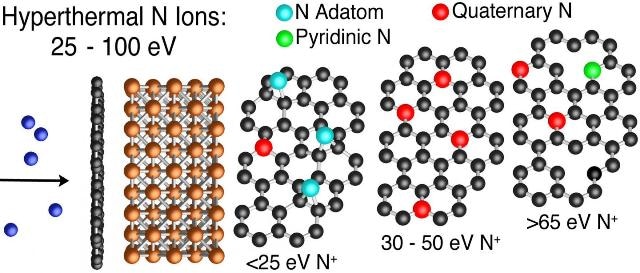Jun 7 2016
A team of researchers from various disciplines at the U.S. Naval Research Laboratory (NRL), Electronics Science and Technology and Materials Science and Technology Divisions, has showed hyperthermal ion implantation (HyTII) as a viable means of substitutionally doping graphene with nitrogen atoms. The outcome is a low-defect film with a tunable bandstructure agreeable to a number of device applications and platforms.
 Schematic displaying the HyTII process depicting nitrogen (N+) incident with a graphene-on-copper (Cu) sample. The three-graphene flake schematics depict the type of modification resulting from N-HyTII processing over the labeled energy range. (Photo Credit: US Naval Research Laboratory)
Schematic displaying the HyTII process depicting nitrogen (N+) incident with a graphene-on-copper (Cu) sample. The three-graphene flake schematics depict the type of modification resulting from N-HyTII processing over the labeled energy range. (Photo Credit: US Naval Research Laboratory)
The research reveals that the HyTII technique offers excellent degree of control including doping concentration and shows depth control of implantation for the first time by doping a single monolayer of graphene in a bilayer graphene stack.
This additionally shows that the ensuing films have superior quality electronic transport properties that can be illustrated exclusively by alterations in bandstructure rather than the defect-dominated performance of graphene films doped or functionalized using other techniques.
Since the discovery that a single atomic layer of sp2 bonded carbon atoms, termed graphene, could be isolated from bulk graphite, a plethora of remarkable electronic and spintronic properties have emerged. However, few applications are forthcoming because graphene lacks a bandgap and its doping is difficult to control, rendering graphene devices competitive only for highly-specialized device technologies.
Dr. Cory Cress, materials research engineer, NRL
Chemical functionalization or doping could affix a usable transport gap. However, these techniques tend to create films that have chance defects, low stability, or non-standardized coverage of dopants and functional groups, which all significantly restrict their usefulness and deform the naturally preferred properties of the graphene film.
As a substitute, NRL researchers influenced their radiation-effects background to build up a hyperthermal ion implantation system with the required accuracy and control to implant nitrogen (N+) into graphene accomplishing doping through direct replacement.
After many months of developing the system, the feasibility of the technique really depended on the first experiment. In our study, we determined the range of hyperthermal ion energies that yielded the highest fraction of nitrogen doping, while minimizing defects, and we were successful in confirming the inherent depth control of the HyTII process.
Dr. Cory Cress
To attain the latter, the researchers executed a bilayer graphene material system made up of a layer of natural graphene, with a majority of carbon-12 (12C) atoms, layered on graphene synthesized with more than 99% carbon-13 (13C). This bilayer material offers a chance to detect which layer they were altering when tested with Raman spectroscopy.
Devices composed of films manufactured using N+ in the range of optimal doping display a transition from strong to weak localization that relies on implantation dose, thus signifying the ability of the implanted nitrogen to modify the intrinsic properties of the film.
As further established by the high electronic quality of the implanted devices over comparable adatom-doped devices, the researchers discovered that the temperature reliance can be fit by a model that considers both band effects because of the substitutional doping and insulator-like effects due to fault formation, with the band effects noticed to be the dominant part.
Unexpectedly, the researchers discovered that a greater amount of nitrogen doping halts the crossover to insulating performance near the charge neutrality point. Defects show up to dictate the performance only at large implantation energies, where defects are more likely, additionally illustrating the differences between true-doped films and preceding defective/doped films.
Our measurements of these devices strongly indicate that we have finally fabricated a graphene film with a tunable bandgap, low defect density, and high stability. We therefore hypothesize that HyTII graphene films have great potential for electronic or spintronic applications for high-quality graphene where a transport or bandgap and high carrier concentration are desired.
Dr. Adam L. Friedman, research physicist, NRL
The study results have been published in ACS Nano 10, 3714-3722 (2016), which illustrates the fabrication technique and efficient doping energy range, and Physical Review B: Rapid Communications 93, 161409(R) (2016), which details the electronic transport properties of devices made from the films. The researchers contributing to the ACS Nano paper include: Dr. Cory D. Cress; Dr. James C. Culbertson; and Dr. Jeremy T. Robinson of the Electronics Science and Technology Division; Dr. Adam L. Friedman of the Materials Science and Technology Division; Dr. Scott W. Schmucker and Dr. Pratibha Dev working at NRL as NRC Research Associates; and Dr. Joseph W. Lyding of the University of Illinois at Urbana-Champaign. The researchers contributing to the Phys. Rev. B: Rap. Comm. paper include: Dr. Adam L. Friedman and Dr. Olaf M.J. van ‘t Erve of the Materials Science and Technology Division; Dr. Cory D. Cress and Dr. Jeremy T. Robinson of the Electronics Science and Technology Division; and Dr. Scott W. Schmucker working at NRL as an NRC Research Associate.